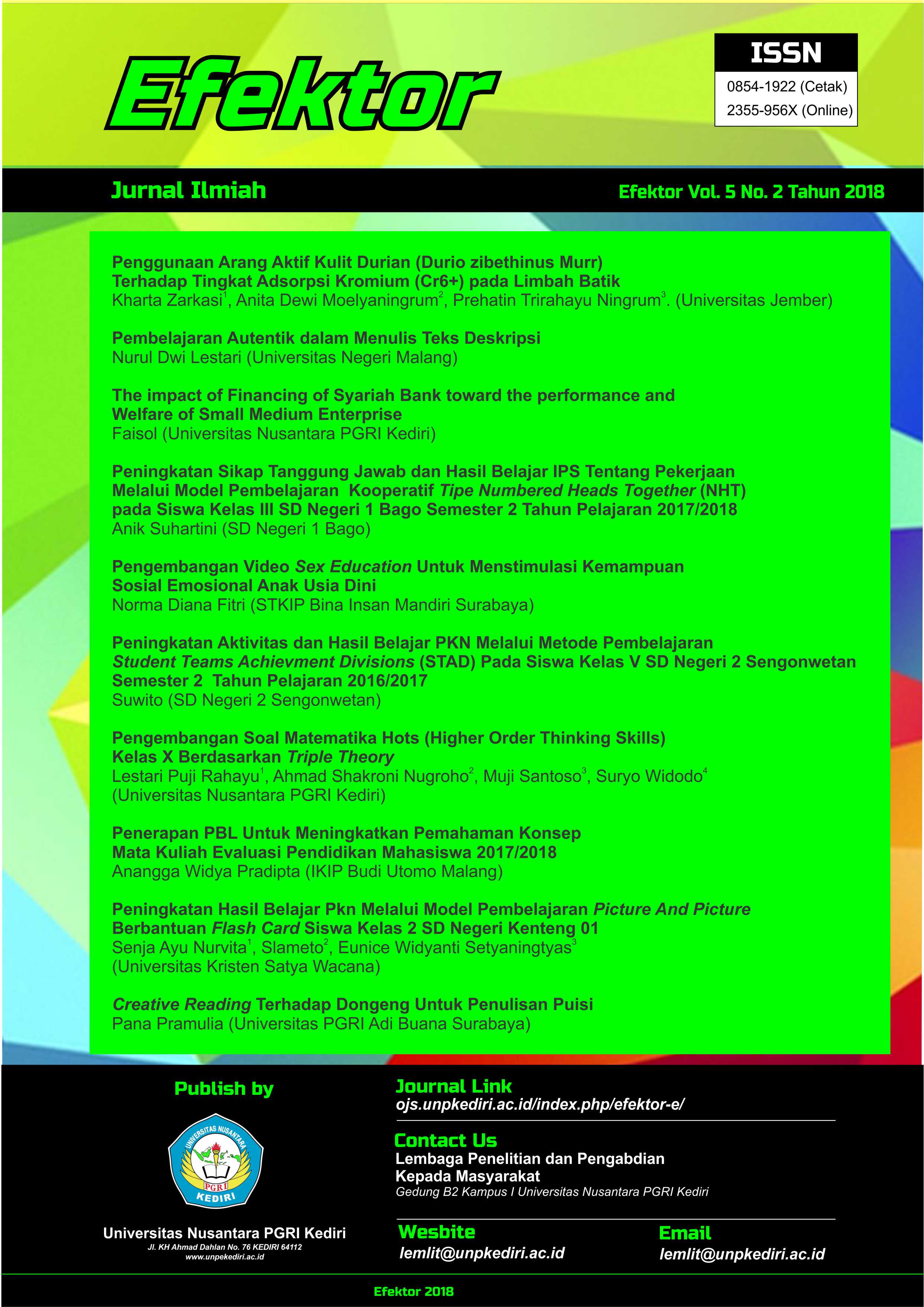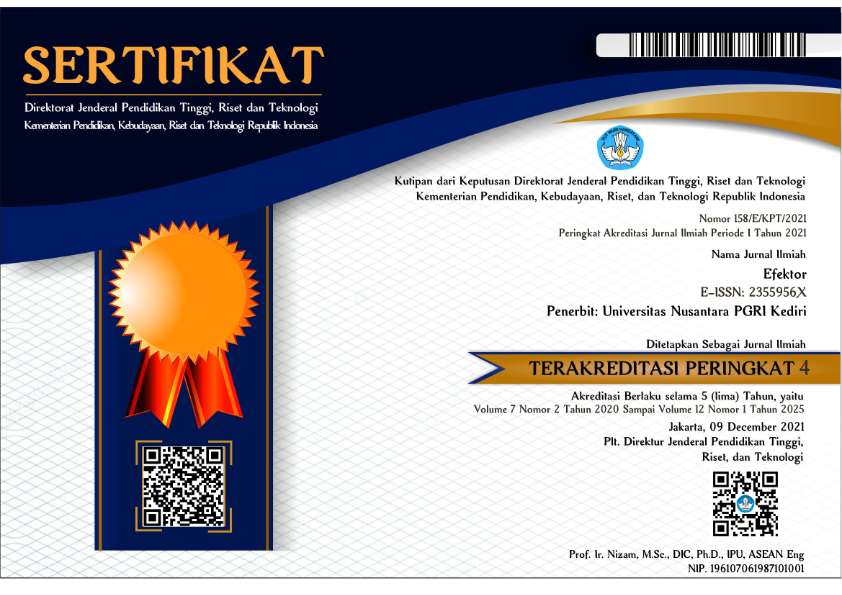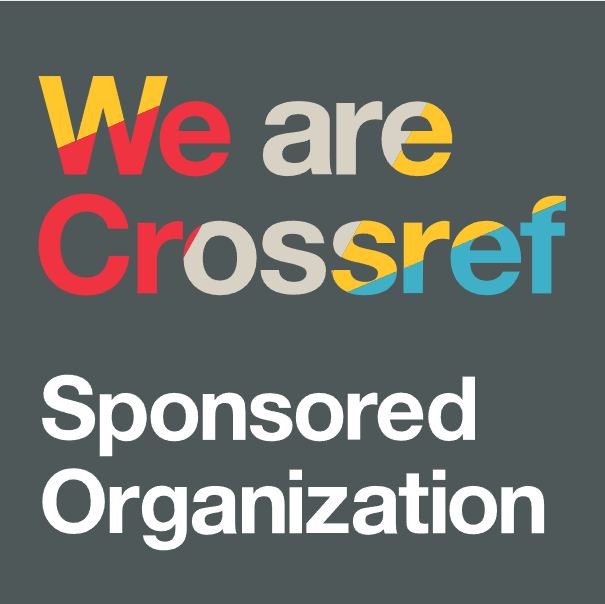Pembelajaran Autentik dalam Menulis Teks Deskripsi
DOI:
https://doi.org/10.29407/e.v5i2.12079Keywords:
pembelajaran, autentik, menulis kreatif, teks deskripsiAbstract
Kreativitas menjadi salah satu keterampilan penting yang harus dimiliki generasi Z untuk hidup di Abad XXI. Keterampilan menulis kreatif teks deskripsi perlu diperhatikan untuk melatih kepekaan siswa dalam menggambarkan objek berdasarkan pengalaman inderawi. Penelitian ini bertujuan untuk mendeskripsikan pembelajaran autentik (authentic learning) dalam mengembangkan keterampilan menulis kreatif teks deskripsi.Adapun tujuan khusus dalam pembahasan ini adalah mendeskripsikanpembelajaran autentik sebagai pemicu berpikir kreatif dalam menulis teks deskripsi, langkah menulis kreatif teks deskripsi dengan pembelajaran autentik, dan penilaian keterampilan menulis kreatif teks deskripsi.
References
Besemer, S.P., & O’Quin, K. (1987). Creative product analysis: Testing a model by judging
instrument, In S.G. Isaken (ed), Frontier of Creativity Research: Beyond the Basic, Bufallo, New York: Bearly.
Blank, W. 1997. Authentic Instruction. Dalam Blank & S.Harwell (Eds.), Promising Practices for Connecting High School to the Real World (hlm. 15-21). Tampa, FL: University of South Florida.
Cropley, D.H., & Cropley, A.J. 2000. Fostering Creativity in Engineering Undergraduate, High Ability Studies, 12, 2.
Donovan, M.S., Bransford, J.D., & Pellegrino, J.W. (Eds). 1999. How People Learn: Bridging Research and Practice. Washington, DC: National Academy Press.
Hakim, M.A. 2008. Kiat Menulis Artikel di Media dari Pemula Sampai Mahir. Bandung: Nuansa.
Hasani, A. 2005. Ikhwal Menulis. Serang: Universitas Sultan Ageng Tirtayasa Press.
Hennessy, S., & Murphy, P. (1999). The potential for collaborative problem solving in design and technology. International Journal of Technology and Design Education, 9 (1), 1-36.
Jabrohim, dkk. 2001. Cara Menulis Kreatif. Yogyakarta: Pustaka Pelajar.
Jonassen, D., Howland, J., Marra, R.M., & Crismond, D. 2008. Meaningful Learning with Technology (3rd ed.). Upper Saddle River: Pearson Education, Inc.
Kurniawan, H. 2014. Pembelajaran Menulis Kreatif. Bandung: Remaja Rosdakarya.
Laur, D. 2013. Authentic Learning Experiences: A Real-World Approach to Project-Based Learning. London: Routledge.
Lombardi, M.M. 2007. Authentic Learning for the 21st Century: An Overview. Educause. (Online), http://www.lmi.ub.edu/cursos/s21/REPOSITORIO/documents/Lombardi_2007_Authentic_learning.pdf) diakses 15 Oktober 2017.
Maxwell, J.C. 2004. Berpikir Lain Dari Yang Biasanya (Thinking for A Change). Batam: Karisma Press.
Munandar, U. 2009. Pengembangan Kreativitas Anak Berbakat. Jakarta: Rineka Cipta.
Newmann, F.M., & G.G Wehlege. 1993. Five Standards of Authentic Instruction. Educational Leadership, 50 (7): 8–12.
Newmann, F., Bryk, A. S., & Nagaoka, J. K. 2001. Authentic Intellectual Work And Standardized Tests: Conflict Or Coexistence? Improving Chicago’s Schools. Chicago: Consortium on Chicago School Research.
Nurgiyantoro, B. 2001. Menulis secara Populer. Jakarta: Pustaka Jaya.
Pranoto, N. 2011. Creative Writing. Jakarta: Primamedia Pustaka.
Priyatni, E.T. 2014a. Desain Pembelajaran Bahasa Indonesia dalam Kurikulum 2013. Jakarta: PT. Bumi Aksara.
Rhosalia, L.U., Laksono, K., Sukartiningsih, W. 2016. Kemampuan Berpikir Kreatif dalam Menulis Naratif Siswa Kelas V Sekolah Dasar Negeri di Kecamatan Gayungan Surabaya. Jurnal Review Pendidikan Dasar: Jurnal Kajian Pendidikan dan Hasil Penelitian, 2 (2): 166-174.
Suparno & Yunus. 2008. Keterampilan Dasar Menulis. Jakarta: Universitas Terbuka.
Downloads
Published
Issue
Section
License
Authors who publish with this journal agree to the following terms:
- Copyright on any article is retained by the author(s).
- The author grants the journal, the right of first publication with the work simultaneously licensed under a Creative Commons Attribution License that allows others to share the work with an acknowledgment of the work’s authorship and initial publication in this journal.
- Authors are able to enter into separate, additional contractual arrangements for the non-exclusive distribution of the journal’s published version of the work (e.g., post it to an institutional repository or publish it in a book), with an acknowledgment of its initial publication in this journal.
- Authors are permitted and encouraged to post their work online (e.g., in institutional repositories or on their website) prior to and during the submission process, as it can lead to productive exchanges, as well as earlier and greater citation of published work.
- The article and any associated published material is distributed under the Creative Commons Attribution-ShareAlike 4.0 International License













